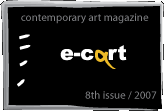1. When you were invited to be a member of the jury that selected the project for the Romanian Pavilion at the Venice Biennale 2007, were any strategies or methodological norms regarding the evaluation procedure communicated to you? Can you detail?
2. What were the general criteria for selection and the priorities that you applied to the participating projects?
3. What were, in your opinion, the qualities that detached the winning project from the others?
4. Do you have any suggestions for improving the selection procedure?
1. I received a sort of regulation that, as a matter of fact, is given to each participant in the contest. In my opinion, there were no norms or methodology in it: “The jury will decide upon rules, criteria and examination modes“. Each member must have thought how to cope with the avalanche of data, documents and files, so that, until the next candidate, to memorize and evaluate the previous one.
2. I don’t apply any general criterion to the projects and I don’t have prejudices. The projects present themselves: they start with a rather long critical text; the colleagues – critics or historians - read it; I don’t, I look at the pictures and the display plans. Why I don’t read? Because, statistically, these texts are external, opinions, and they aren’t organically related to the project’s construction. Their presence is grotesque (Take bread, it will appease your hunger!). Concurrently with the presentation of the projects, I make a list with grades as in school and some sort of subtitles for them.
(My) priorities: when I am asked what project I support, I get rid of banalities, sweet naiveties and les déjà vu-s (obsolete). What is sustainable for me is a project quasi impossible, a proposal for which there are no present practical solutions, so the author must fall over himself in the next phase (negotiations with the Ministry). Thus I think a new thing could be obtained.
3. The statement that they would ask only a small amount of money, in the Decorativa or Recom execution modes. Another possible reason is the fact that the opinion of a young and well-known artist was heard, according to which he would do for himself something with anti-flags starting from the old one, with the hole. I was surprised to see again a project realized by others, more trivial in comparison with the original one, only conceived.
4. The Pavilion lies in the claws of this sleeping monster – the Ministry of Culture. Since it always claims to have insufficient money and it’s afraid of other monsters such as the Ministry of Foreign Affairs (with the Romanian Cultural Institute in Venice) and the Foreign Intelligence Service (which cast a glance everywhere something official takes place “over the borders” “and they offer an opinion”), the launch of the contest should be entrusted to curators, i.e. those people who make a project viable, not cutting off the budget or mutilating ideas. The Ministry must state clearly how much money it allocates for the Venice Biennale and from this amount scaffolding must start. The rejected projects can be achieved somewhere else, because this is what the curator worked for. In such a situation, the jury of the peevish and ironical faces, not knowing what to admire first, will finally have something to choose for that massive space between the Polish and the Greek ones.
Ion Grigorescu




















